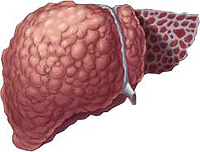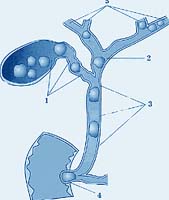«Standed to Zirroz» - there is such a steady expression. Indeed, the unlimited use of alcohol very often leads to this serious liver disease.
Content
There are few cirrhosis, so not many know that only cancer, AIDS and myocardial infarction can be worse. At least, if judge by mortality in patients. Men, mostly cirrhosis suffer from medium and old age.
What is liver cirrhosis?
Cirrhosis in Greek means «Redhead, lemon-yellow». It is this shade that acquires a red liver in the norm. Cirrhosis of the liver — This is a change in the structure of the liver, in which normal hepatic cells are replaced by Rubtsov.
Causes of liver cirrhosis
Two most important reasons leading to liver cirrhosis — Viral hepatitis (first of all, hepatitis B, hepatitis C) and alcoholism.
The development of the disease also play a role:
- poisoning of toxic substances (for example, polanty core, some drugs);
- Diseases of the gallbladder and bile ducts, accompanied by a long jaundice;
- hereditary factors (found very rarely);
- Failures in the work of the immune system: the body unexpectedly begins to produce substances damaging their own liver.
What's happening?
The change in the structure of the organ and the loss of normal hepatic cells leads to the fact that the liver is not able to synthesize proteins and other substances necessary to the body, as well as to neutralize toxins. The scarring tissue squeezes blood vessels, which leads to a circulation disruption.
Symptoms:
 Liver dimensions change: it increases or decreases.
Liver dimensions change: it increases or decreases.- Sharp «grows» stomach. This is due to the accumulation of fluid in the abdominal cavity (ascites).
- Meteorism, nausea, feeling of bitter mouth, belching, urinary delay.
- Total weakness and weight loss.
- Viennes are expanding on the front wall of the abdomen: a bluish pattern appears around the navel resembling «head jellyfish».
- Red spots appear on the chest, back and shoulders, similar to asterisks or small spiders. Blush palm.
- Men have breast glands, their hair falls out in the axillary region and on the leaf, the ability to river falls.
- Women disappears menstrual cycle.
- Man complains of frequent headaches, violation of attention and memory, which is associated with the accumulation of blood not neutralized toxic liver.
- The veins of the esophagus are expanding, but it can only be seen in terms of gastroscopy.
- It is possible to develop jaundice and skin.
Strong pain in the cirrhosis of the liver does not happen. Sometimes it is bothering a feeling of gravity and new pain in the right upper half of the abdomen, provoked by violations of diet and physical work.
Cirrhosis is incurable, has a progressive perennial current and is particularly dangerous by its complications.
Diagnosis of liver cirrhosis
To put the correct diagnosis, a gastroenterologist after inspection sends a patient to:
- blood chemistry;
- blood test for virus hepatitis markers;
- Uzi liver and other abdominal organs:
- Gastroscopy (EGDS) — to assess the state of the veins of the esophagus and determining the risk of bleeding;
- liver scintigraphy — Radioisotope study that allows you to assess the work of various departments of the authority;
- Computer tomography — to assess changes in liver and other abdominal organs;
- In some cases, liver biopsy.
Treatment of liver cirrhosis
Cure cirrhosis is impossible, only in the early stages of the disease there is a chance to slow it. When typical cirrhosis, the hepatologist will only help relieve unpleasant symptoms and slow down the development of complications.
The basis of the treatment of liver cirrhosis — Therapeutic measures:
- Diet: Exclusion of oily, fried dishes, alcohol, salt limit and protein, refusal of alcohol;
- diuretic;
- Antiviral therapy — It is rare, but sometimes allows you to slow down the development of the disease;
- Plasmferres— Cleansing blood from toxins if the liver ceases to cope with this task itself. In exacerbation of the process or development of the patient's complications, it will be put to the hospital.
Surgical treatment may be required:
- Paracentsis — Punching pound walls allowing you to remove the accumulated liquid from the abdomen;
- Performing an operation to create new ways for blood current (shunt operations) — A rather traumatic and complex operation requiring high qualification of the vascular surgeon;
- Bien transplantation.









